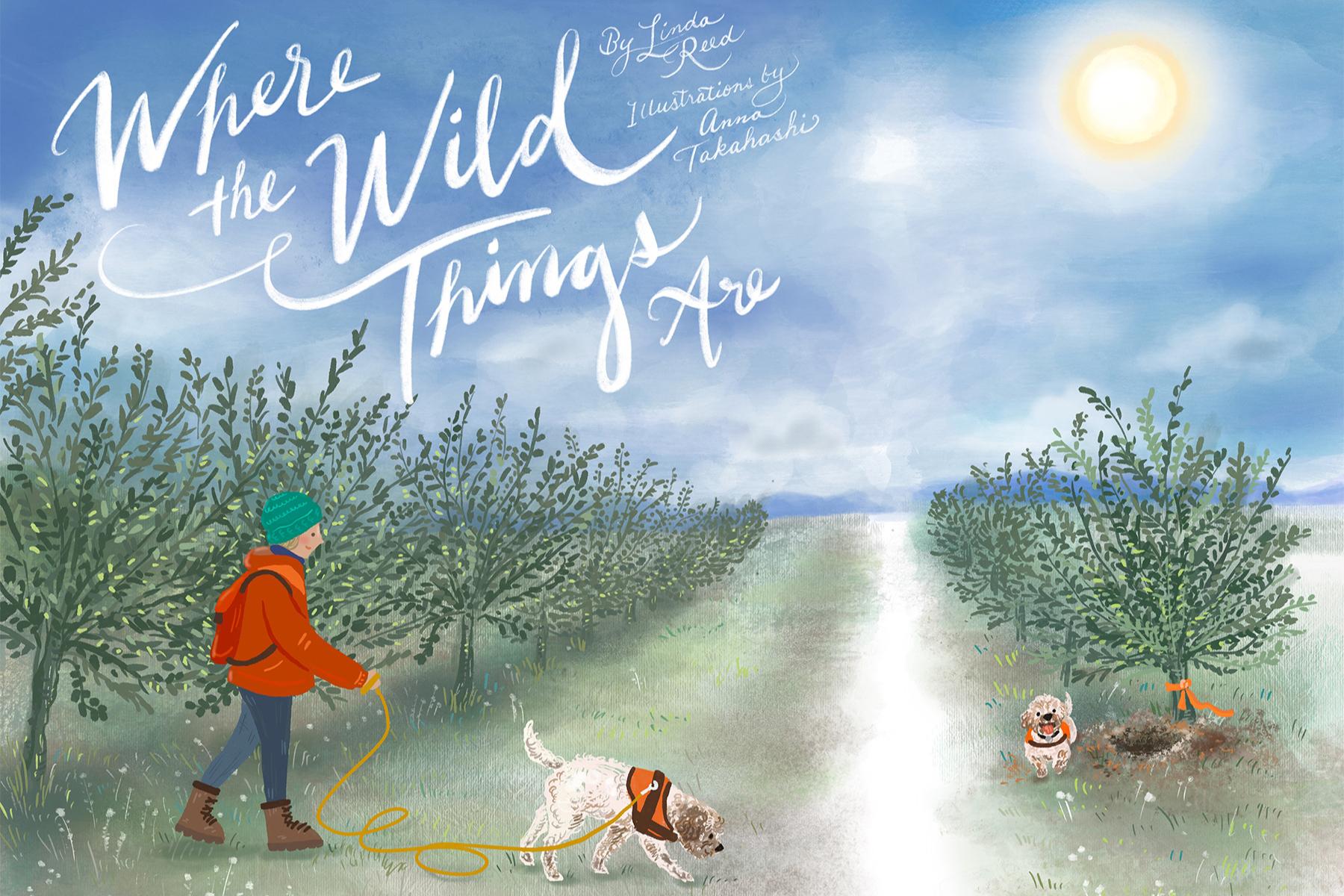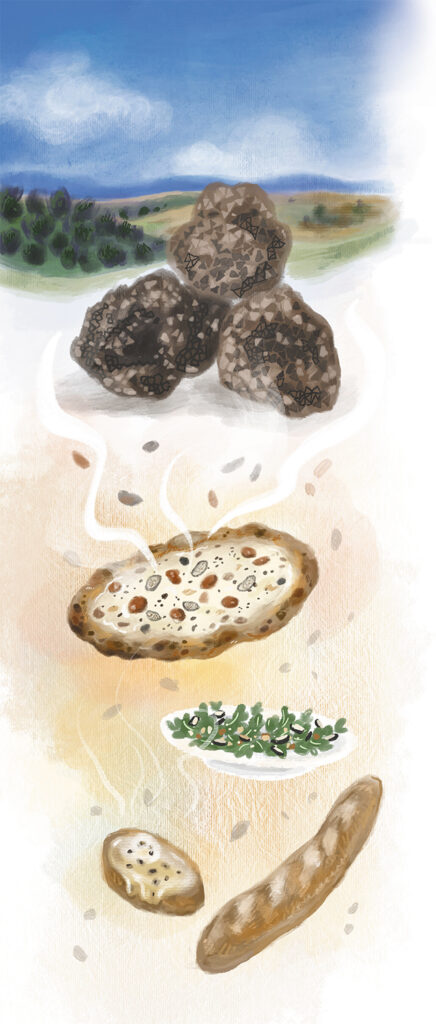
Where the Wild Things Are
Truffle dogs have special sensory skills that allow them to sniff out truffles, which are a prized fungus that is used on pizza, pasta and more. This Edible story shares how Caelesta Vineyard in Paso Robles is capitalizing with this hunting and gathering experience.
Story by Linda Reed
Illustrations by Anna Takahashi
On a chilly winter morning, shaggy-haired canine named Lolo guides a team of amateur truffle hunters into the woods of the Templeton Gap. “Almost any breed can be trained to hunt, but Lagottos seem to be born for it,” says Alana McGee, Lolo’s handler and the Founder of Truffle Dog Company. Lolo is a Lagotto Romagnolo, an American Kennel Club recognized breed that looks like a poodle mix with curly dense fur. It’s a type of waterfowl terrier from Italy and the only breed officially recognized as a truffle hunter. Lolo leads the group on a hunt for the prized edible fungi.

Truffles have an almost mystical presence in culinary circles. They are the fruiting body of a subterranean ascomycete fungus found all around the world, though mostly in Spain, France and Italy. More than 100 genres of fungi are considered truffles, but the most commonly known is the black truffle, called the winter black or Perigord. November through February is ideal for a truffle encounter.
Caelesta Vineyard Owners Brian and Denise Farrell, along with their winemaker son, Brian Jr., run the vineyards, winery and truffière, where the truffle hunt is taking place. The tours run around two hours and are hosted by Brian Jr. and Alana, a certified Professional Dog Trainer specialized in training truffle dogs.
Working with Pierre Sourzat, a French expert on truffles, in 2015, the Farrells planted a 10-acre orchard containing 2,200 holly oaks specially inoculated with Tuber melanosporum, if Périgord truffle. The trees are about seven feet high and are trimmed to encourage root growth and more opportunities for the fungus to spawn in the mycorrhizal network, the underground mushroom nursery.
It takes years for the spores to create fruit. If a farmer is lucky, the soil is just right and the weather cooperates, then the first truffles may appear after five to seven years. After that first harvest, production volume can increase exponentially up to 20 to 30 pounds an acre. Given that Prigords can sell for between $1,000 and $2,400 per pound, depending on their size — a bigger diameter equals more per pound — the financial payoff comes somewhere around year 10 or later. The Farrells’ first harvest, which emerged in the winter of 2022, was an encouraging four pounds. In a reminder that nature is an important partner in farming, the heat waves in the summer of 2022 pushed soil temps over 100 degrees and negatively impacted the crop.
During a hunt, Lolo runs among the trees, her trained nose sniffing around the base of the oak trunk in a zone called the brûlé, where the soil is fungus rich. She’s been known to detect the fruiting body two-and-a-half feet under the ground. She stops and places her nose on the dirt where she detects a scent. Alana rewards Lolo with a treat then flags the tree with a bright orange streamer. The canine is already off smelling for more, so there is no time for digging during the actual hunt.
“It isn’t an exact science,” Alana notes. “Dogs are not machines.” Lolo can work for around two hours before losing interest and energy. Alana returns later to the marked trees and digs up the earthen gold.
To humans, black truffles smell earthy, smoky and sweet, and this scent will last about five days. Alana recommends using truffles before that happens. They can be sliced over pizza, as in many restaurants, but that is just scratching the surface of what can and probably should be done with them. Because a truffle’s volatile aromatic compounds (aka VOs) bind with any fat or alcohol, its flavor can be infused into anything containing fat, as long as the truffle is still aromatic. Alana suggests wrapping the truffle in paper towel, putting it in a glass bowl and letting it sit for a few days next to the food you want to infuse. Some options are butter, oil, eggs, smoked salmon, avocado and brie cheese. Be careful not to overdo it, though.
After walking around the orchard watching the dog hunt, guests head back to the winery for a savory lunch featuring the Caelesta truffles. In 2023, the menu featured whipped truffle butter on Hush-Harbor Artisan Bakery baguettes from Atascadero, an arugula salad and pizzas from Via Caravaggio 147 of Paso Robles, garnished with shaved Périgords and served with a wine tasting flight of Caelesta wines. Brian Jr. utilizes a mix of new and neutral French oak barrels, stainless steel and concrete tanks to age the wines.
The Farrells sell their Caelesta truffles to two Central Coast restaurants, both with a Michelin star: Six Test Kitchen in Paso Robles and Bell’s in Los Alamos. In the future, wine club members may also have the opportunity to buy them.
Whether foraging for these hidden treasures on foot or savoring them on the fork, truffles are a modern-day delicacy that offers bites of the wild.

